- Forage Species
- Forage Management
- Publications
- Forage Focus
- Related Links
- Variety Testing
- Frequently Asked Questions
- Alabama Forages Home
- ACES Livestock & Poultry
What Clover Do I Have?
Jennifer Johnson, Ph.D
Assistant Professor/Extension Specialist
Alabama Cooperative Extension System
Crop, Soil and Environmental Science Auburn University
When spring begins to approach and the vibrant seedheads of various clover species start to pop up across the state it is a good time to get face to face with your clover and determine what you are working with. While many of us are able to identify that the legume in front of us is, in fact, clover, determining what species of clover can be a little more difficult.
Like many other legumes, clovers can be a valuable asset to forage management programs. Not only are clovers known for improving the diets of grazing animals, increasing the yield, and extending the grazing season when grown with other forages. They can also improve the soil, provide biological nitrogen, decrease fertility needs, and be a beautiful addition to the land.
While some clovers are easily identifiable, others may be more of a challenge. Focusing on the physical characteristics of clover species, their similarities and differences can help us determine what species we are trying to identify.
While in a single year we are unable to determine the life cycle of the clover, we can determine when and where it is able to grow. The following are clovers that are most adapted and widely used in Alabama.
Arrowleaf Clover
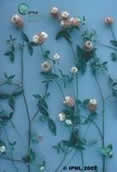
Arrowleaf clover is a cool season annual clover most easily identified by its’ “arrow” shaped leaflet. A defined “V” variegation mark on the leaflet, and lack of pubescence allow arrowleaf clover to be easily identified in vegetative stage. A large white and pink-tinged bloom allows it to sometimes be confused at first glance with larger white clover varieties, but its’ leaf shape aids greatly in identification. Arrowleaf clover’s growth occurs mostly in mid-to late spring and it produces a high percentage of hard seed allowing it to potentially be seen in the same area for multiple years (although it is an annual).
Ball Clover
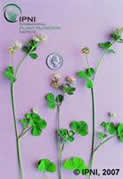
Ball clover is a winter annual that is often confused with white clover. Vegetative ball clover is identified by oval leaflets with faint variegation, and no pubescence. The yellowish to white tinged blooms are typically smaller and more rounded than white clover, but the easiest characteristic that distinguishes Ball from White clover is the multiple leaflets and branched stems produced, along with a very aromatic flower. Ball clover’s growth typically occurs in early to mid-spring and it can be successfully grown on many soil types. A prolific seed producer under heavy stocking rates and a high percentage of hard seed, allow ball clover to potentially be seen for multiple years.
Berseem Clover
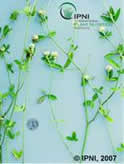
Berseem cloveris a cool season annual often confused with Alfalfa. Its’ elongated leaf shape and lack of variegation and pubescence in the vegetative stage can potentially confuse passersby, but on closer look the lack of leaf serrations make it easy to identify this clover. It produces a small white seedhead, and if planted in autumn will achieve most of its growth in mid-spring. Not as commonly used as other annual clovers due to a lack of cold tolerance, within a 100 miles of the Gulf Coast it often produces more autumn and winter forage than any other clover. Quite tolerant of wet and alkaline soils, Berseem clover is a good clover choice for the southern part of Alabama, but does not reseed well due to low levels of hard seed production.
Crimson Clover
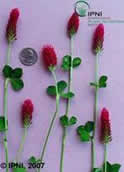
Crimson clover is a very common winter annual in the South. Easily identified by a long and vibrant crimson seedhead, Crimson clover is one of the more dependable, highly productive annuals in Alabama. Its’ high productivity and dependability can be attributed to a larger seed and better seedling vigor than most clovers. In the vegetative stage it is identified by having a dark green oval leaflet, defined “V” variegation, and dense long pubescence on stem and leaves. Crimson clover is the earliest maturing clover species commonly grown in Alabama as it makes much of its growth during cooler weather. This makes it an excellent match for use with winter annual grasses as a winter cover or grazed forage component.
Red Clover
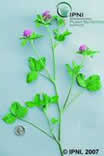
Red Clover is a cool season perennial that can act as a biennial or annual in certain parts of the Southeast. With large seed and excellent seedling vigor, red clover is easily drilled into existing grass pastures. In the vegetative stage red clover is easily identified with large oval leaflets, defined variegation and lots of pubescence. When used in areas well adapted, it is the best yielding clover species. Red clover is grazed often, but must be utilized in rotational grazing systems.
Subterranean Clover
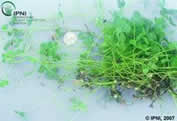
Subterranean clover is a cool season annual clover best suited to areas with mild winters. This dense, low-growing annual has a small white seedhead, but is easilydefined by a heart shaped leaflet with faint black specs and pubescent leaves. Subterranean clover can produce seed under heavy grazing pressure, but is one of the lowest yielding commonly used clover varieties. This clover is more tolerant of shade and low fertility than other clovers.
White Clover

White clover is a true perennial and the most widely grown clover in the United States. When planted in adapted areas, it can perenniate for several years. Identified by its’ oval leaflet, lack of pubescence and white seedhead, white clover can be commonly seen in many areas (yards, pastures, roadsides). White clover is a good choice for many pastures as it is very tolerant of close grazing. There are three common white clover types often found in the Southeast (white dutch, intermediate, and ladino). Distinguishing between them can be difficult. Refer to table 2 to help better identify which white clover you have.
Identifying Characteristics of Select Clovers
Life Cycle |
Climatic Adaptation |
Leaflet shape |
Variegation -V mark on leaves |
Pubescence - Hair on stems/leaves |
Flower head (Size) |
Flower head (color) |
||||
(A, P) |
(CS, WS) |
(Y/N) |
(Y/N) |
|||||||
Arrowleaf |
A |
CS |
Arrow |
Yes |
No |
Large |
White, Pink-tinged |
|||
Berseem |
A |
CS |
Elongated |
No |
No |
Small |
White |
|||
Ball |
A |
CS |
Oval |
Yes (Very Faint) |
No |
Small |
White |
|||
Crimson |
A |
CS |
Oval |
Yes |
Yes |
Long |
Crimson |
|||
Red |
P |
CS |
Oval |
Yes |
Yes |
Clustered |
Pinkish-violet |
|||
Subterranean |
A |
CS |
Heart |
Black spot |
Yes |
Small |
White |
|||
White |
P |
CS |
Oval |
Usually yes |
No |
Clustered |
White |
|||
Distinguishing Between Ball and White Clover
Seed head |
Flower |
Stems |
Leaves |
Notables: |
|
Ball |
Very small and round (end of a small marker) |
Several flowers on same stem More aromatic than white |
Stems with several branches |
Toothed margin on leaves Several leaves on same stem |
Reseeds well under grazing conditions |
White (Dutch) |
Very Small(almost as small as ball) |
Flower on single stem Seed head only slightly bigger than stem |
Unbranced Stem |
Leaves on single stem |
Clumpier - less consistent stand than the others |
White (Intermediate) |
Medium |
Flower on single stem Seed head medium in size |
Unbranced Stem |
Leaves on single stem |
Grows pretty small when cold or just getting started -good reseeder but less productive than ladino |
White (Ladino) |
Large (potentially larger than red) |
Flowers on single stem Seed head may be bigger than red clover |
Unbranced Stem |
Leaves on single stem Leaf as large as red clover (or greater) |
Very large upright growth - more easily defined in a pasture - generally most productive of the white clovers but does not reseed well |

 Menu
Menu



